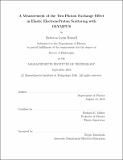| dc.contributor.advisor | Richard G. Milner. | en_US |
| dc.contributor.author | Russell, Rebecca Lynn | en_US |
| dc.contributor.other | Massachusetts Institute of Technology. Department of Physics. | en_US |
| dc.date.accessioned | 2017-02-22T19:00:48Z | |
| dc.date.available | 2017-02-22T19:00:48Z | |
| dc.date.copyright | 2016 | en_US |
| dc.date.issued | 2016 | en_US |
| dc.identifier.uri | http://hdl.handle.net/1721.1/107042 | |
| dc.description | Thesis: Ph. D., Massachusetts Institute of Technology, Department of Physics, 2016. | en_US |
| dc.description | Cataloged from PDF version of thesis. | en_US |
| dc.description | Includes bibliographical references (pages 185-190). | en_US |
| dc.description.abstract | Elastic electron-proton scattering has long been the tool of choice for the study of the proton form factors, GE(Q 2 ) and GM(Q2 ), which describe the electric and magnetic distributions of the proton as a function of momentum transfer. Recent experiments, measuring the form factors from polarization observables in polarized elastic electron-proton scattering, have found values of the ratio GE(Q2 )/GM(Q2) at high Q2 that contradict the results from unpolarized measurements. A proposed explanation for this discrepancy is the unaccounted two-photon exchange radiative correction, which could affect the unpolarized measurements. As this effect is currently not possible to calculate in a model-independent way, the OLYMPUS experiment was designed to make a direct measurement of it by measuring the elastic positron-proton to electron-proton scattering cross section ratio. The experiment was run in 2012 at DESY using the BLAST spectrometer and the DORIS positron and electron beams at 2 GeV incident on a gaseous hydrogen target. To analyze the data, a careful reconstruction of the scattering events, detailed simulation of the experimental setup, and full radiative corrections to the measured cross sections were performed. Preliminary results for the experiment show a statistically significant two-photon exchange effect, increasing over the measurement range of 0.6 GeV2 < Q2 < 2.35 GeV2 . These preliminary results suggest that two-photon exchange could explain the GE(Q2)/Gm(Q2 ) puzzle. | en_US |
| dc.description.statementofresponsibility | by Rebecca Lynn Russell. | en_US |
| dc.format.extent | 190 pages | en_US |
| dc.language.iso | eng | en_US |
| dc.publisher | Massachusetts Institute of Technology | en_US |
| dc.rights | MIT theses are protected by copyright. They may be viewed, downloaded, or printed from this source but further reproduction or distribution in any format is prohibited without written permission. | en_US |
| dc.rights.uri | http://dspace.mit.edu/handle/1721.1/7582 | en_US |
| dc.subject | Physics. | en_US |
| dc.title | A measurement of the two-photon exchange effect in elastic electron-proton scattering with OLYMPUS | en_US |
| dc.type | Thesis | en_US |
| dc.description.degree | Ph. D. | en_US |
| dc.contributor.department | Massachusetts Institute of Technology. Department of Physics | |
| dc.identifier.oclc | 970697390 | en_US |
